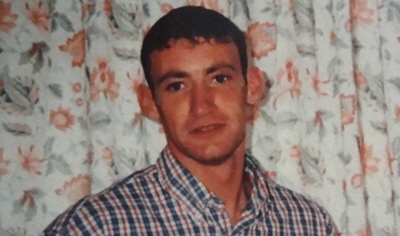


Paul Alliston
Chris Morrison
Martin Johnstone
A catalogue of errors led to the sinking of an island fishing boat with the deaths of three men, according to an investigation report.
The MFV Louisa went down while at anchor by Mingulay -
The body of skipper Paul Alliston was later seen floating in the water but slipped under the waves about half a mile away.
Martin Johnstone, 29, from Caithness, died while trying to swim to shore.
Father-
Lachlan Armstrong, from Stornoway, survived after managing to swim ashore.
The wreck of the Louisa was salvaged and taken ashore in Glasgow for tests by the Marine Accident Investigation Branch.
Inspectors concluded that the cause of the foundering was flooding of the hold.
The report said the skipper and crew had all gone to bed in the accommodation, and the hold bilge alarm failed to wake them because the alarm sounder in the crew cabin had previously been disabled.
The events leading up to the flooding and the circumstances in which it occurred could not be conclusively determined, but water probably entered the hold from the deck wash hose which is thought to have been left running thus allowing water to spray against the open hold hatch cover.
The four crew abandoned the crab boat after 42-
But the liferaft did not inflate because a servicing sub-
Although they had all donned lifejackets, the skipper and two crew became unresponsive through cold water immersion and were later found face down in the water by the rescue services.
The time of the sinking is unknown but a satellite picked up an initial distress signal by 3.32am. But the first request for rescue helicopter or lifeboat was not made by coastguards until 4.22am
Inconsistent terminology for emergency beacon positions used by UK mission control centre and the coastguard, coupled with insufficient knowledge of the systems, caused confusion and delayed the search and rescue operation, said investigators.
Had the rescue services arrived on scene earlier, it is possible that there would have been more survivors, highlights the report.
Chief Inspector of Marine Accidents Steve Clinch said: “The scope of this safety investigation has been necessarily broad. It has required the MAIB to raise the wreck of Louisa, and to conduct a thorough examination and a number of tests aimed at determining what caused the vessel to sink while at anchor.
“In the absence of any identified material defect, we have concluded that the vessel probably foundered as a result of its deck wash hose flooding the hold while the skipper and crew were all asleep.
“A previously disconnected bilge alarm sounder prevented them from being alerted to the flooding until just before the vessel foundered. These factors highlight operational deviations from best practice and an underestimation of the risks involved.”
Mr Cinch added: “A failure of Louisa’s liferaft to inflate and a delay in the arrival of search and rescue assets meant that, after abandoning the vessel, the skipper and crew depended on their lifejackets for survival.”
A lifejacket should turn an unconscious person onto their back and keep their airway clear of the water.
“It is therefore of concern that the skipper and two crew were tragically found unresponsive and face down in their lifejackets when the rescue services arrived on scene,” he added.
Lifejackets can be officially approved without undergoing real life situation type
tests -
“As a matter of urgency,” the MAIB recommends the MCA conducts further research ascertain the suitability of lifejacket water performance tests.
The 42-
The four crew abandoned the crab boat after Paul Alliston, skipper of the vessel, went into the flooding wheelhouse to grab lifejackets for them all.
But the liferaft did not inflate and the fishermen were left in the cold sea, hanging onto the side of the barely, floating device.
Martin Johnstone, 29, from Caithness, died while trying to swim to shore when the Louisa went down about 250 metres off Mingulay Bay.
Father-
Lachlan Armstrong, 27, from Stornoway, made it to rocks after freeing up space on
a makeshift semi-
Locals said the body of Paul Alliston was later seen floating in the water, close to shore, about half a mile away.
He is still missing despite land, air and sea searches.
An action to declare him dead has now been raised at Stornoway Sheriff Court under the Presumption of Death (Scotland) Act 1977.
A public notices states: “An action has been raised in Stornoway Sheriff Court, by Wilma McMillan, Andrew Damien McMillan, and Nicola Marie Mackinnon, Pursuers, to declare that Paul Alliston, Defender, whose last known address was 2 Shieldinish, Lochs, Isle of Lewis, is dead.”
The notice says that any person wishing to defend or challenge the action must be formally included to the legal process by lodging an application to the court by Thursday.
The Lousia has been salvaged on behalf of the Marine Accident Investigation Branch (MAIB) which is probing the accident.
She was raised off the sandy seabed by a heavy lift floating crane in May.
The government body pledged to examine all details in an effort to establish the cause of the tragedy and to highlight any safety issues.
Tests have been carried out on the wreck which is now ashore at a yard at Clydebank on the River Clyde.
The overall investigation is due to take many months.
The crew of the MFV Louisa were asleep while the vessel lay at anchor in a calm sea.
They woke up shocked to find the boat sinking.
Quickly throwing on whatever clothes they could find, the four leapt out of their bunks and scrambled up on deck to find cold seawater coming onboard fast.
Speaking after the incident, survivor Lachlan Armstrong said the 16-
Mr Armstrong said they struggled to release the vessel’s only liferaft. Then it failed to inflate leaving the crew to cut open its hard cover protective case and manually unfold the interior rubber material into some kind of floating sheet as best they could.
Despite the turmoil, the four acted calmly and collectively to create some sort of “makeshift raft as a means of escape.”
But their combined weight had the sea lapping at their necks, pulling down the barely floating sheet of rubber.
Recalling the accident at the time, Mr Armstrong explained: “We were all in the sea and it was just the lifejackets we had on holding us up.”
The semi-
The men tried to stay out of the water but “were just falling straight back in again” as they struggled to keep afloat in the sea.
“You were so cold you couldn’t even hold onto it.
“I have no idea how I found the strength to keep going."
Mr Armstrong had said: "The water was so cold and we were all immersed in the water.
“The raft never inflated -
“Being that cold you know the only way you can survive is to get out of the water.”
Martin Johnstone swum for land with the light from his lifejacket tracking his progress closer to the shore.
Thinking Mr Johnstone had reached safety, Mr Armstrong also decided to try to swim for the island, not knowing if he would make it.
He thought the drifting make-
Lachlan Armstrong made it to rocks where he clung for hours. He was later picked up by Barra lifeboat. A coastguard helicopter flew him to hospital in Stornoway.
Ends
Early on 9 April 2016, the fishing vessel Louisa foundered, with the loss of three
lives, while anchored close to the shore in Mingulay Bay in the Outer Hebrides. The
skipper and crew, who had been working long hours before anchoring late the previous
evening, had woken suddenly as the vessel was sinking rapidly by the bow. They were
able to escape to the aft deck, activate the emergency position indicating radio
beacon (EPIRB), and to don lifejackets. However, they were unable to inflate the
liferaft as they abandoned the vessel. At 0232, an alert from Louisa’s EPIRB was
detected by a geostationary search and rescue satellite and forwarded through the
Cospas-
Catalogue of errors led to fishing boat tragedy
26 July 2017